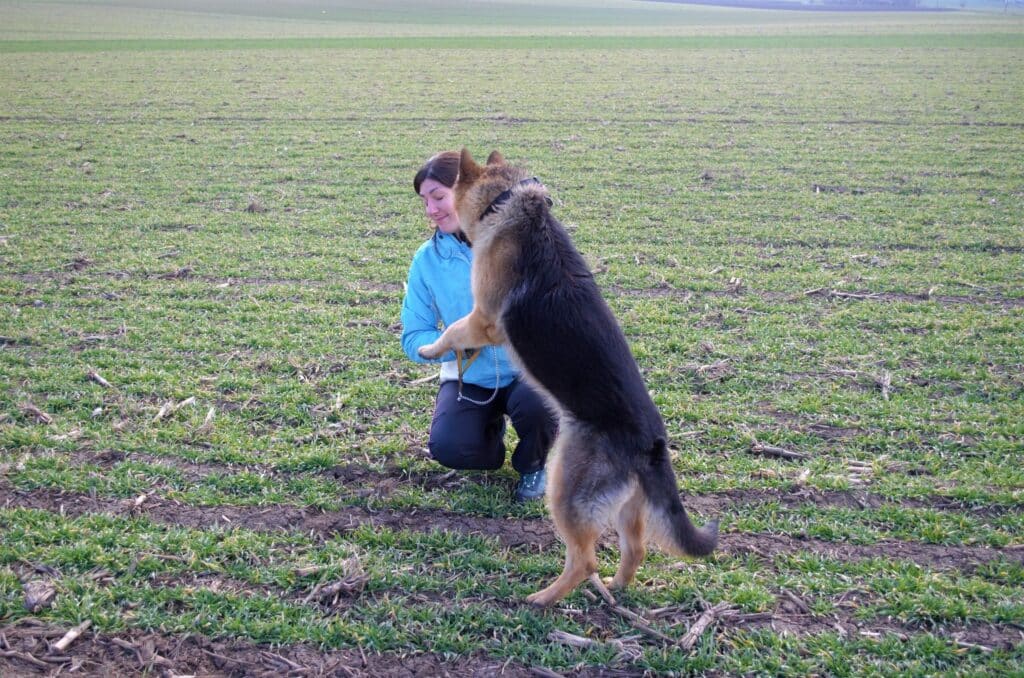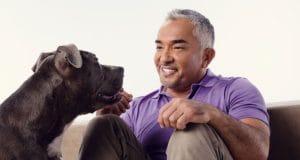You’ve probably heard the expression “jump for joy.” While it’s usually not literal for humans, it’s a pretty good description of someone’s emotional state when they’re very happy. To jump implies moving upward, and human happiness can definitely elevate our mood.
But, despite the expression, real happiness in humans is exhibited by an inner calmness and contentment, and with a gesture as simple as a smile. The only people who show happiness by jumping up and down are probably the ones who’ve just won a lot of money or a car on a game show.
Welcome Home!
And yet, when you come home and your dog starts jumping up and down and running in circles, what’s your first impression of their mood?
“My dog is so happy to see me.”
That’s probably what you think, and you’re probably happy to see your dog, but do you start jumping up and down, too? Most likely not. And your dog isn’t doing it out of happiness. She’s doing it out of excitement due to excess energy. If your dog is the type to suffer from separation anxiety, then the jumping is probably coming from frustration and nervousness as well.
An excited dog in this situation is not a happy dog.
Excitement vs. Happiness
For a dog, unfocused excitement is excess energy that has no direction. Something’s going to happen, but the dog doesn’t know what, and it expresses this through its body. Humans do the same thing too — think of a time when you found yourself pacing, or unable to sit down or stop fidgeting. Were you doing that because of happiness? No. It was probably due to anxiety.
As long as we continue to perceive a jumping, spinning dog as happy and respond to it that way, we will keep on making our dogs constantly anxious. What’s the typical response to a dog showing excitement when his human comes home? Giving affection. It’s hard not to. The dog is cute, we love the dog, and we interpret its actions as demonstrating love for us — so it’s very natural to reply to that love with a pat on the head, a hug, or praise.
Affection As Reward
I’ve spoken and written about this many times, but it’s always worth repeating. To our dogs, affection is a reward. It doesn’t matter what state of mind a dog is in. When we give it affection, we are reinforcing that state.
Think of it as film in a camera. The film is blank until it’s exposed to light, but then it captures whatever image is projected onto it forever. In this case, your dog’s mind is the film, its behavior is whatever is on the other side of the lens, and reinforcement is you pushing the button to open the shutter and make the image permanent.
If you give affection to an excited dog, you teach your dog to be excited. If you give affection to a fearful dog, you teach your dog to fear. If you give affection to an aggressive dog, you teach your dog aggression. And so on. Misbehavior plus reinforcement equals a trained misbehavior.
When To Give Affection
Ideally, we want our dogs to be calm and submissive, because that is the energy state in which they are most receptive to our rules. This is the only state we should ever reward with affection; the only time we should push the button and take the picture.
Another important part of it is this: the only way we can earn and keep our dog’s trust is by reinforcing that calm, submissive state. If we reward our dog for being unbalanced or excited, then they will see us as unbalanced, and dogs do not follow unbalanced energy. This is the quickest way to wind up with an excited, assertive, confused dog that will try to be the Pack Leader every chance she gets.
Managing Excitement
Of course, this doesn’t mean that we should never encourage our dog’s excitement, but there’s a time and place for it. The time and place are when we can focus that excited energy on something that is fulfilling to the dog’s instinctual needs — playing fetch in the dog park, for example, or taking your dog through agility or herding training. The excitement and excess energy is there, but it’s for the purpose of doing a job (for you), in the context of discipline and, via exercise, with the goal of exhausting that excited energy.
And when that excited energy is exhausted and your dog is calm and submissive, then you can give all the affection that you want — and eventually you’ll learn that dogs, like humans, can express outrageous happiness through something as simple as a smile.
Stay calm, and smile if you’re happy.
Get sounding dog advice right in your inbox. Subscribe to Cesar’s free newsletter.











